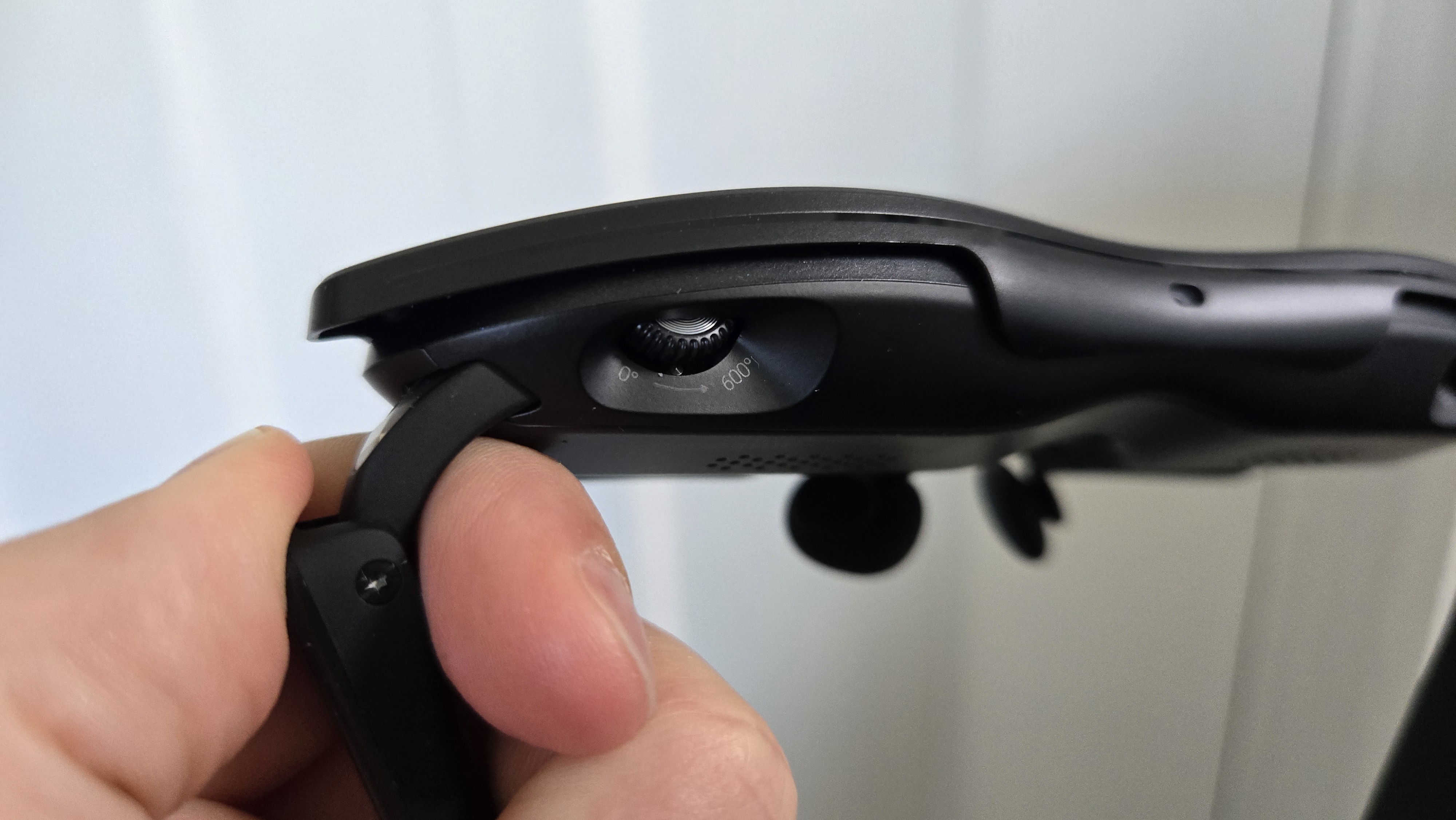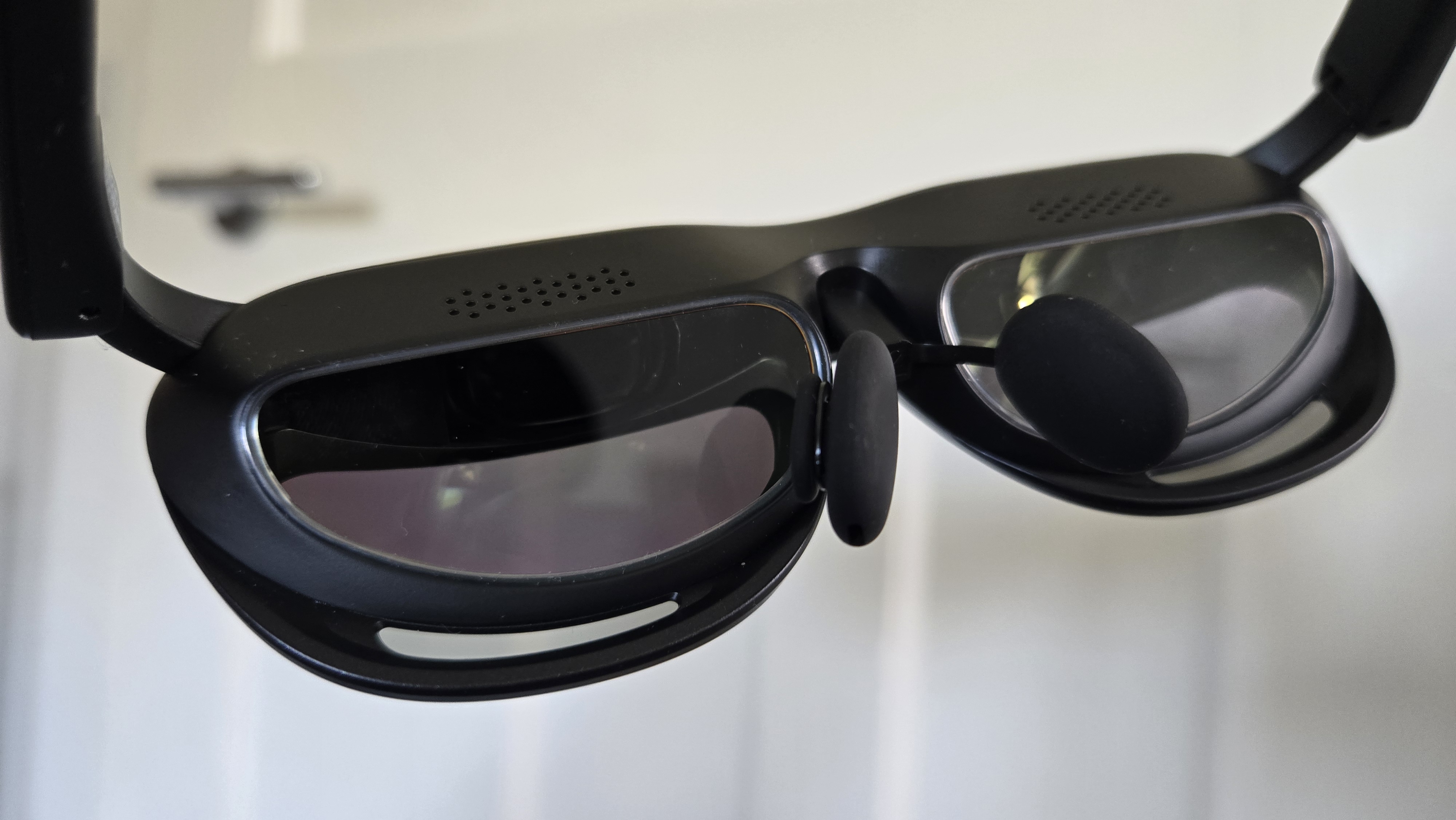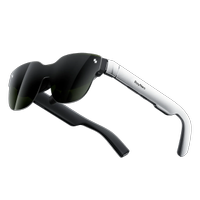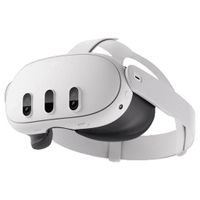Rokid Max 2: One-minute review
The Rokid Max 2 AR glasses are a solid pair of smart specs that are ideal for entertainment – watching films, and playing games – if you’re a fan of the big-screen experience, and especially if you’d like to take that experience on the go.
They boast a comfortable design which you can wear for hours, and while they’re generally very similar to rival smart glasses they do boast built-in myopia adjustment. Using a dial above each lens you can adjust the screens to suit a prescription in the 0.00D to -6.00D range without the need for add-on lenses.
This factor alone will be enough to win over some who have been frustrated by the difficulty of getting prescription lenses for other smart glasses.
Performance-wise they sit in the middle of the pack, with a solid 600-nit full-HD image from their 120Hz OLED displays. At a 50-degree field of view they can produce a large virtual screen, though their rivals can offer bigger.
What’s more, their audio is only, in a word, fine. You could make do without headphones if you’re at home, but if you’re out and about, or want the best possible sound, Bluetooth cans are a must.
At their full price of $529 / £399 this performance is a little disappointing, but at their regularly discounted price of $429 / £319 or less they're a much more compelling option in the smart glasses space.
If you won’t be advantaged by the myopia adjustment, though, you’ll probably prefer one of their competitors, such as the more affordable and impressive RayNeo Air 3S which feature on our best smart glasses list. But the convenient adjustments are a massive benefit that shouldn’t be ignored by people who would benefit from them.

Rokid Max 2: Price and availability
- Available in the US and UK for $529 / £399
- They can often be found discounted
The Rokid Max 2 AR glasses are available in the US and UK priced at $529 / £399, though you can often find them discounted for $429 / £319 at sites including Rokid’s own store.
If you get them for full price you’re probably overpaying compared to some of their rivals (at least in the US), but at a discounted price the Rokid Max 2 AR glasses are a very competitive option.
You can turn the glasses into a more standalone device by picking up the Rokid Station – an Android TV puck for the specs – for an additional $199 / £159 (though we’ve often seen this discounted to $139 / £109)
- Value: 3.5/5
Rokid Max 2: Design
- Lightweight and comfortable design
- Myopia adjustments between 0.00D and -6.00D
- Polarized outer lens and cover to cut out background distractions
We’ve been here before. These Rokid Max 2 smart glasses, like others of their kind, look a lot like sunglasses, albeit with thicker frames, and a few details which become noticeable on closer inspection.
There's a USB-C port at the end of the left arm for connecting them to compatible devices via their USB-C to USB-C cable. There are control switches on the right arm for volume and screen brightness, and replaceable nose clips, so you can find the best fit for your face.
They’re comfortable to wear – at 2.65oz / 75g they’re very lightweight, and can be easily worn for hours at a time.
Plus, to help the glasses’ image stand out while you’re using them, you have two backdrop options.
The more open choice are the glasses’ polarized lenses. These cut out background distractions but still allow some light in – perfect for keeping an eye on your surroundings while you watch a show.

You can also outfit the specs with their lens cover to block out all light and enjoy an improved (but more closed off) visual experience. There’s much less background light to compete with the image, giving it a sharper look and brighter colors, though you will have to be okay with being cut off from the outside world.
I’ve become quite used to electrochromic dimming tech in these sort of glasses, which has its advantages – chiefly it’s easier to swap between full immersion and full passthrough in a pinch – but the Rokid Max 2’s approach has proved itself as the next best thing in my testing thanks to its simplicity yet effectiveness.
Something the Rokid specs bring to the table which is fairly unique is built-in myopia adjustment. A dial above each lens allows you to adjust the screen in real-time from 0.00D to -6.00D.
This won’t be ideal for every user, but it’s certainly a handy upgrade that will mean fewer people will need to buy an optional lens upgrade to make the smart glasses usable.
- Design: 4.5/5
Rokid Max 2: Performance
- Uses Sony micro-OLED panels
- 120Hz refresh rate, 600-nit brightness, full-HD image
- Mediocre audio

With Sony micro-OLED panels – which in conjunction with the optical setup boast a 120Hz refresh rate, 600-nit brightness, and 100,000:1 contrast ratio – the full-HD image these glasses can produce is really good.
That's especially the case when you use the lens cover as a backdrop. With a complete lack of background light the image can seriously pop, with good contrast and bright colors, that, combined with a 50-degree field of view that leaves space for a giant virtual screen, create an immersive private cinema experience.
I used the Rokid Max 2 glasses to watch several shows and films including Captain America: Brave New World and Dandadan, and played games by connecting the specs to my PS5 – using them, among other things, to collect the last few Clair Obscur: Expedition 33 trophies I was missing.
Audio-wise the glasses aren’t bad, but they’re nothing to write home about either.
Their performance is passable if you’re in a quiet space, but they can feel a little lacking at times, with dialogue and music coming through the built-in speakers feeling as if it's been hollowed out. My advice: pick up a pair of the best Bluetooth headphones along with these specs (if you don’t already have some) if you want to get the best experience.
Not only will this improve the sound, it’ll help you to minimize ambient noise if you wear the smart glasses while traveling on a plane or train, which are the best places to use these kinds of AR specs.

The only let-down performance-wise is that the optical system the glasses use can mean the image is disrupted by reflections.
The glasses use lenses to reflect the OLED screen’s image into your eyes, but that same lens can also reflect your chest into your view as well. In darker environments it’s less noticeable, and unless you’re wearing something very loud it’s generally not too distracting, but since testing the Xreal One Pros which use a different (and better) lens setup I’ve found the issue is much more pronounced on other glasses, and that's certainly the case here.
That said, the Xreal One Pros cost considerably more, and if you haven't tried those specs and been spoiled by their new approach to AR optics, which minimizes issues with reflections, you shouldn’t find too many reasons to get frustrated by the Rokid Max 2 and other glasses with the older style of lenses.
- Performance score: 3.5/5
Should you buy the Rokid Max 2 glasses?
Swipe to scroll horizontally
Performance | Performance-wise the Rokid Max 2 glasses are, in a word, fine. We've seen and heard worse, we've seen and heard better. | 3.5/5 |
Design | The myopia adjustment helps elevate the Rokid Max 2 experience for prescription-glasses users, but they're not quite flawless in other areas. | 4.5/5 |
Value | If you can pick up the Rokid for a discounted price it’s much better value; at its list price it’s a less appealing option compared to the competition. | 3.5/5 |
Buy them if…
You have prescription glasses
If you need eye glasses and a prescription in the 0.00D to -6.00D range these specs have in-built myopia adjustment that’ll save you having to pay extra for a lens insert to use these smart glasses.
You travel a lot
Smart glasses are perfect for travelers – I use them all the time while commuting to work on the train, or when I fly.
You want privacy
These glasses can help you hide what you’re watching from people around you while still letting you see the screen, making it perfect for binging that comfort watch you’re embarrassed to admit you like, or to get some work done while commuting without having people peeking over your shoulder.
Don't buy them if…
You’re getting them at full price
The glasses seem to be perpetually on sale at Rokid’s own store, and the reduced cost is a much better deal than paying full price.
You want the best specs possible
The Rokid Max 2 glasses are good, but there are better options out there, though they will generally cost you more.
You want 4K
If you’re waiting for 4K quality visuals you’ll need to keep waiting, as like every other pair out there the Rokid Max 2 glasses are full-HD only.
Also consider
Xreal One
The Xreal One AR smart glasses cost more at $499 / £449, and offer a better HD image and enhanced Bose audio.
Read our Xreal One review
RayNeo Air 3S
These budget smart glasses punch well above their weight with an overall quality that's generally on a par (even slightly better in some ways) than these Rokid glasses, though they do have downsides.
Read our: RayNeo Air 3S review
Meta Quest 3
While not a direct competitor to these AR smart glasses, the Quest 3 is an XR product you should consider if you want to experience what VR and MR have to offer – it’s simply superb.
Read our Meta Quest 3 review
How I tested the Rokid Max 2 AR glasses
To review the Rokid Max 2 glasses I tested them over a two-week period, using them in a variety of environments including at home, on a plane, and on the train.
I mostly used the glasses with my Samsung Galaxy Z Fold 6 to watch movies and shows, but using an HDMI-to-USB-C cable I was also able to use the Rokid Max 2 to enjoy some gaming through my PS5, which allowed me to test their refresh rate and input delay, and see if the specs helped or hindered my gaming abilities.
- First reviewed June 2025













 English (US) ·
English (US) ·